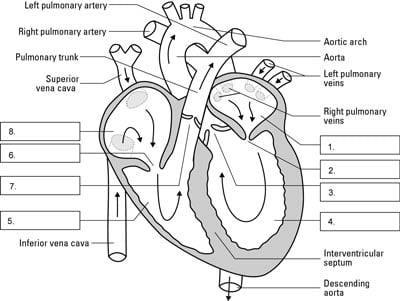The heart and circulatory system of a human, as well as some other mammals, are complex. These large animals need to have a higher blood pressure to push the blood throughout their entire bodies. This need results in a two-circuit circulatory system, a system that has two distinct pathways:
One pathway is for pulmonary circulation, which first delivers deoxygenated blood to the lungs so it can become oxygenated and then delivers oxygenated blood back to the heart.
The other circuit is for systemic circulation, which carries oxygenated blood from the heart to the rest of the body and back.
The human heart has four chambers:
Two ventricles, muscular chambers that squeeze blood out of the heart and into the blood vessels. They reside at the bottom of the heart.
Two atria, muscular chambers that drain and then squeeze blood into the ventricles. They reside at the top of the heart.
Your heart is divided into halves because of your two-circuit circulatory system, so you have a left atrium and a left ventricle, as well as a right atrium and a right ventricle. Your heart’s right side pumps blood to your lungs, and its left side pumps blood to the rest of your body. Blood goes into both pathways with each and every pump.
Valves separate one chamber of the heart from another. Each valve consists of strong flaps of muscle tissue, called cusps or leaflets. When your heart is working properly, the valves open and close fully so blood can only flow in one direction through them.
Four valves separate the four chambers of your heart from one another and from the major blood vessels that are connected to it (see the following figure):
The right atrioventricular (AV) valve is located between the right atrium and the right ventricle. This valve is also referred to as the tricuspid valve because it has three flaps in its structure.
The pulmonary semilunar valve separates the right ventricle from the pulmonary artery. Semilunar means “half-moon” and refers to the valve’s shape.
The left atrioventricular (AV) valve is located between the left atrium and the left ventricle. This valve is also called the bicuspid valve because it has only two flaps in its structure.
The aortic semilunar valve separates the left ventricle from the aorta. Like the pulmonary semilunar valve, this valve has a half-moon shape.
For questions 1–8, use the terms that follow to label the valves and chambers of the human heart in the following figure.
a. Left AV valve
b. Right ventricle
c. Pulmonary semilunar valve
d. Right atrium
e. Left atrium
f. Aortic semilunar valve
g. Left ventricle
h. Right AV valve

The following is how the figure should be labeled:
e. Left atrium
a. Left AV valve
f. Aortic semilunar valve
g. Left ventricle
b. Right ventricle
h. Right AV valve
c. Pulmonary semilunar valve
d. Right atrium

